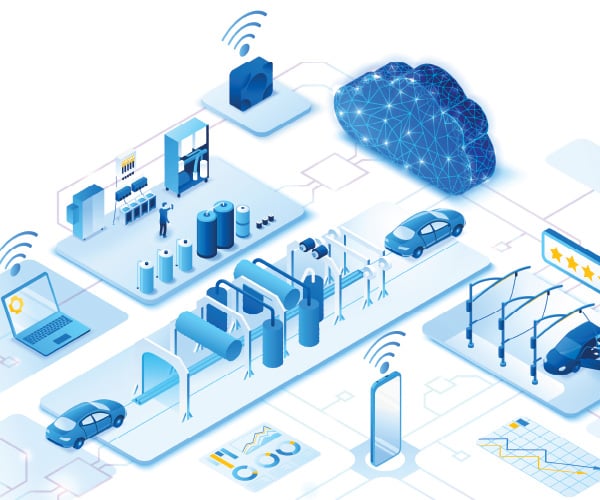
Using Data to Guide Your Business
October 10, 2022
11 minute ReadBy Lindsey Quick
As our world becomes more connected, businesses have the opportunity to collect data on nearly every aspect of their operation and use it to describe, predict and improve performance. Data analytics is the process of recognizing insights from data — finding trends in the information available and using that data to improve a situation. These insights and trends can then be used to hone and influence business operations.
Within a car wash, more and more equipment is interconnected and gathering all kinds of data, such as the number and type of cars coming through, that help operators predict what will happen, like proposing which packages consumers are most likely to buy. The data will tell operators how long each wash takes and pick up on any inconsistencies. With all of this data available, how can wash owners and operators use the information to improve their businesses?
Watching the Data Flow
Andy Agostini, vice president of operations for Magnolia Wash Holdings, knows the value of data. “Data can be a powerful tool if you know how to use it properly,” he said. Headquartered in Charlotte, N.C., Magnolia Wash Holdings operates a fast-growing organization of express car wash locations throughout the southeast United States.
According to Agostini, there’s no shortage of valuable data points in the car wash industry. The challenge comes when it’s time to compile and analyze that data.
“Making sense of it all can be a challenge,” Agostini said. “Here at Magnolia, we’ve been focusing on two aspects of data: how to better collect and consolidate data and how to ensure our team understands how to effectively use it to make decisions.”
To address the former, Magnolia created their own central data warehouse that allows them to pull in data from multiple data sets to run custom queries accordingly.
“For example, there will be a direct flow of data from all our separate POS platforms across all sites,” Agostini said. “This lets us pull real-time performance of all sites in one easy-to-read view. We will also be able to layer in additional data sets such as our accounting information, site-level timeclock data or weather data.”
To help team members best use the data in decision-making, Magnolia created multiple operating KPIs to measure performance. As the data comes in, the team can create action plans based on what the numbers show, allowing them to establish benchmarks of what optimal performance looks like.
Chris Andersen, vice president of business development for GO Car Wash, also understands the value of data analytics. Headquartered in Denver, Colo., with 104 locations across the United States, GO Car Wash created their own data analytics application.
“We have created proprietary applications related to specific processes,” Andersen said. “At the site level, our leaders have real-time data on their key metrics to run their business.” For example, the team has a damage claim app that connects the customer, the company and repair facilities into real-time data on the progress of a damage claim at any time.
One of the key pieces of data for GO is membership. Their systems allow team members at any site to pull up the application on their phone or tablet and see, in real-time, where that site is in terms of adding new members.

Data Analytics 101
If you’ve been hesitant about incorporating data analytics into your business, it’s understandable: there seems to be an infinite amount of data that can be collected and an equally infinite number of ways to analyze it.
Jason Baumgartner is senior vice president of marketing for NCS. NCS provides real-time insights into car wash operations by connecting a wash to its equipment, chemicals, vacuums and back room. This allows for a single pane of glass to track and monitor things like vacuum performance, chemical dosing and tunnel performance. At NCS, that data is collected, anonymized and aggregated to allow NCS to provide operators with predictive equipment failure alerts, or variance on chemical levels or dosing to make sure their tunnel is operating at peak performance and efficiency.
Baumgartner said there are four main analytics categories: descriptive, diagnostic, predictive and prescriptive.
“Most operators are able to do descriptive analytics: describe what is happening in the numbers,” he said. “With some framework and perspective, most operators can also tackle diagnostic analytics: describing what is happening with the numbers and understanding why.”
When it comes to predictive and prescriptive analytics, Baumgartner said it takes a much larger pool of sites and data, and might be an opportunity for an owner or operator to partner with a vendor who specializes in data analytics, unless they have a large sample size — more than 25 sites — to work with in order to get to statistical significance from the data.
Making Sense of the Data
“Data isn’t all just charts and graphs,” said Chris Moriarity, senior vice president of strategy for Suds Creative, a part of DRB, a company that has supported growth in the car wash industry with point-of-sale and wash optimization software, hardware and service for decades. DRB also includes DRB Tunnel Solutions, DRB In-Bay Solutions (formerly Unitec) and Washify, and is headquartered in Akron, Ohio.
“If you know how to look at data, it tells a story: The who, what and when,” said Moriarity. “Your data reveals how your customers see you and what they value. Data that doesn’t lead to a strategy and action may be interesting, but it’s not that useful.”
From Moriarity’s perspective, data reduces the risk and the anxiety of not knowing what levers to pull and when. “It allows you to see around the corner,” he said. “And plan and prepare for the growth you desire.”
How Data Is Collected
Nearly everything in a wash environment is capable of collecting valuable data, from the point-of-sale platform to the sensors in the wash, and even security cameras.
Harriet Ayoade, vice president of marketing at EverWash, shared how their tool, omniX Analytics, works. omniX leverages computer vision and proprietary machine learning models to capture vehicle recognition data from existing security cameras. “Our technology is able to identify, in real time, vehicles and their baseline attributes such as make, color, license plate, body type, whether we have seen it before, and if so, how many times, and of course how long it has been present in any part of the store,” Ayoade said. omniX then converts that vehicle recognition data into actionable insights to help car wash owners and operators drive more revenue per visit, increase margins and operate more efficiently.
Understanding the Potential of Data Analytics
For Ayoade, data is empowerment. “As a marketer, the opportunity to empower attendants at car washes with intelligence on prospects is very exciting,” she said. “We can recognize a vehicle in real time as it approaches the pay station. omniX can tell if it’s a retail customer and how many times they have visited and when it was last seen, and then compare it to patterns of other customers.” This information can then trigger a real-time notification sent directly to a sales attendant with the best pitch message.
“Imagine how different a pitch can be if you know this is a previous member, someone on a promotion, a first-time visitor or a frequent visitor,” Ayoade said. “This not only increases conversion but creates a more contextual and targeted message for that customer.”
Improving Your Operations and Sales
After collecting that data and understanding what it’s capable of illustrating, car wash owners and operators can begin capitalizing on it through changes to their operations and increasing sales.
One example for improving operations with omniX is that it can detect queue lengths in real time or tell an operator how efficiently their loader is operating when compared to median KPIs.
“A notification can then be sent to the manager or HQ alerting them of the delay, enabling them to take action to assist immediately rather than read about it the next day in a report or worse, from a customer complaint email,” Ayoade said.
The tool is also able to provide predictive and learning capabilities and insights gained from the data. “omniX can predict sales volume for the next day by hour at each of your locations or whether a customer is likely to churn,” Ayoade said. “All of this will help you manage your business better going forward.”
At Magnolia, where growth has primarily come through acquisitions, Agostini said that there can be a broad spectrum of analytical abilities and infrastructure at the site level.
“By implementing our playbook, we’ve been able to educate our site leadership teams on how to effectively use data as well as providing them with improved reporting,” Agostini said. This has helped sites make more objective decisions and gives them visibility into how their peers are performing, adding some healthy competition.
“Another great example of seeing tangible results from data comes from our labor optimization model,” Agostini said. “This model generates ideal schedules for sites based on historical volume levels by hour by day. This helps site managers with scheduling and resulted in a significant decrease in overall labor costs.”
Getting Started
For Baumgartner at NCS, data collection starts with creating a baseline. “What gets measured gets managed, and what is managed improves,” Baumgartner said. “Understanding where you are currently relative to where you want to be — establishing a baseline —
is the first step.”
Baumgartner said he believes you don’t have to go too far to
get started.
“For most owners and operators, the data is already available to you — believe it or not,” he said. Once you get insight into that data, you can create action to improve the measures. To get started, Baumgartner recommends pulling together and reviewing the last 13 months of two or three easy-to-find data points, such as car count, member count and revenue per car.
“Lay out each month in a time series to understand how your wash is trending,” he said. “Then make a list of three to five lead levers that influence those data points. For example, for Member Count, look at enrollment rate, churn rate, and the number of non-member visits would be three that affect the result. Next, create a strategy to influence each of the lead measures and track your result. What gets measured gets managed, and what
is managed improves.”
Keeping It Simple
Moriarity from Suds Creative believes there’s one data point that tops all the rest. “Don’t get lost in all the talk about machine learning and artificial intelligence,” he said. “None of those tools mean a thing if you don’t have contact information.” According to Moriarity, if you’re not collecting contact information for your customers, you’re not only leaving a ton of money on the table, but you’re also vulnerable to competition.
“Contact information gives you the chance to build a relationship,” he said. “Relationships foster loyalty and make people less price conscious.”
Agostini said that knowing your main drivers for sales is critical. “Once you’ve identified those drivers, you can analyze the data that impacts those metrics,” he said. “For example, if you set a goal of hitting 10,000 cars per month and you fall short, you need to dive into potential causes. Was it weather related? Or maybe it was due to operational challenges? Or lack of effective marketing? Data can help point you in the right direction to diagnose the root cause of weak performance.”
Agostini recommends just getting started. “I certainly understand not all operators have the bandwidth or budget to create central data warehouses like ours,” he said. “That said, there is already a lot of great data out there for any size operation.” He recommends that owners just starting out should take advantage of the reports available in their point-of-sale platform — and then keep going.
“Start with simple reporting to get your team used to looking at these KPIs,” Agostini said. “Once everyone is comfortable evaluating the basic reporting, add in additional layers to drill into performance more.”
If you’re feeling overwhelmed, that’s okay. “To get started, you don’t need to be very analytical to pull and evaluate high-level reporting with the express wash business model,” Agostini said. “Keep it simple and easily digestible.”
From there, you can get creative with pulling custom reporting. “A basic understanding of Microsoft Excel is usually all you need to slice and dice POS data,” Agostini said. “Ultimately, as you scale and you begin to open multiple sites, investing in an internal financial or data analyst can be very beneficial, but it’s certainly not a requirement. There are also great options to bring in a third-party firm to help develop new data sets and dashboards.”
Andersen with GO echoed those sentiments. “Keep the metrics simple and don’t focus on too many things,” he said.
Using a Vendor
There are many data analytics companies an owner or operator can use to help with their data efforts.
“Don’t be afraid to find an expert
you can trust, and then listen to them, and make sure they listen
to you,” Moriarity said. “Data tells a story, but it’s not the whole story. Most of the time, good data insights complement what you could already feel in your gut. You need to
trust both.”
At DRB, every customer has access to overall transactional data collected through the point-of-sale system — the data that goes into everyday reporting and helps keep the books straight. “It includes things like car counts, plans sold, general sales statistics and more,” Moriarity said. “DRB customers can access this information 24/7/365 through our online reporting engines.
“For customers who really want to take it to the next level, they can engage Suds,” Moriarity said. “Suds goes beyond traditional marketing tactics, driving customer revenue and profit by turning complex data into actionable insights.”
Ayoade said she believes a partner can make a huge difference. “We can help car wash operators understand not only their existing members and how they engage, but also those that are yet to be members who visit your store,” she said. “This provides real time and predictive capabilities for the entire customer lifecycle but also how your wash performs operationally.”
Whether you’re interested in partnering with a vendor or trying it on your own, using data analytics to describe, predict and improve your business is fast becoming a non-negotiable. The insights will help owners and operators rethink the way they do business, from how decisions are made to how new campaigns are developed to boost sales, and show you the likely path to success. “We all know that change is guaranteed: your customers
will change, your competition will change and the economy will change,” Moriarity said. “Data is your compass that not only prepares you for the changes but allows you to fully leverage them.”








